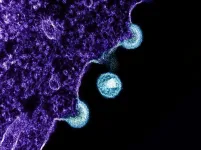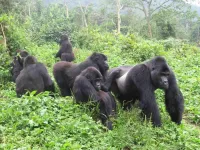(Press-News.org) RIVERSIDE, Calif. -- After COVID vaccination, it usually takes weeks for our bodies to develop protective antibody responses. Imagine, however, a vaccine that speeds up the production of antibodies against SARS-CoV-2, the virus that spreads COVID-19.
A research team led by Rong Hai, an associate professor of microbiology and plant pathology at the University of California, Riverside, has developed such a vaccine by using preexisting immunity to a separate virus (the influenza virus) to help kickstart the process of making antibodies against SARS-CoV-2.
“Any delay in the immune response to SARS-CoV-2 means there is some time when people are left poorly protected against the virus,” Hai said. “Our vaccine is designed to get people those protective antibody responses faster, so they are not vulnerable to the coronavirus. This is better protection for everyone. It could be especially valuable for people who still lack immunity to SARS-CoV-2, such as children.”
Study results appear in the Journal of Virology.
To develop the new design, Hai and his colleagues targeted SARS-CoV-2 as a representative pandemic virus and generated a “fusion protein” vaccine that combines the nucleoprotein from influenza A virus and the receptor-binding domain, or RBD, of the SARS-CoV-2 spike protein. The SARS-CoV-2 virus uses the spike protein to attach to a receptor on the surface of cells — the first step in the infection of the cell by the virus. Antibodies against RBD block the interaction of the spike protein with the receptor, thereby preventing the virus from infecting the cell.
The new vaccine design addresses a long-standing challenge in the field of virology: the delay in developing protective adaptive immunity for emerging viral pathogens. Hai explained that in any infection antibodies are made by a type of cell called the B cell. Each B cell produces one antibody against one specific target; only a small subset of B cells, however, can produce antibodies against RBD.
“For more B cells to become activated and start producing antibodies against RBD, two steps are needed,” said Harrison Dulin, the first author of the paper and a former graduate student in Hai’s lab. “First, the B cell needs to encounter the RBD protein, and second, the B cell needs to be activated by another cell called a helper T cell. At the start of an immune response against SARS-CoV-2, there are only a few helper T cells around that can help activate the RBD-specific B cells. This causes a delay in mounting the antibody response against the pathogen.”
According to Hai, the new vaccine design has the advantage of allowing the RBD-specific B cells to derive help from a pool of readily available helper T cells generated in response to a flu infection.
“The flu helper T cells are harnessed to activate the RBD-specific B cells, speeding up the process of antibody production,” he said.
Encouragingly, the new design can be used even in countries with limited financial resources.
“Given the simplicity of our new design, it would not require these countries to acquire any additional complicated or expensive equipment,” Hai said. “We designed the vaccine so that it could be administered the same way as currently available vaccines.”
The new design stemmed from another project led by Hai, which aimed to design a dual vaccine platform for both influenza and SARS-CoV-2 virus. Although the research team only tested the vaccine against SARS-CoV-2, in principle the new design can be used to speed up antibody responses against other emerging pathogens.
“It could be especially useful if we ever have to deal with SARS-CoV-3 or some other novel pandemic virus,” said coauthor Emma H. Wilson, a professor of biomedical sciences in the UCR School of Medicine.
Hai cautioned more work needs to be done in the lab before the newly designed vaccine is made available to people.
“So far, we have only tested the vaccine in mice,” Hai said. “We need to explore through clinical trials if this vaccine is safe for humans. It’s a long process. Further, preexisting immunity to influenza can vary from person to person, and we know that immune responses can wane over time. We need to test this vaccine in a range of immune backgrounds to see how widely applicable our strategy is.”
The research project made use of the newly established biosafety level 3, or BSL-3, lab at UCR.
“We needed to show that the antibody responses produced by our vaccine could effectively neutralize live SARS-CoV-2,” Hai said. “Because SARS-CoV-2 is a dangerous and highly contagious virus, working with live versions of the virus can only be done in BSL-3 labs.”
Hai, Wilson and Dulin were joined in the research by Duo Xu, Arrmund Neal, Edward Vizcarra, Jerald Chavez, Arzu Ulu, Keidy Wuang, Nikhil Bhakta, and Chanvoraboth Chea of UCR; and Ramya S. Barre, Myeon-Sik Yang, Siddiqur Rahman Khan, and Luis Martinez-Sobrido of the Texas Biomedical Research Institute in San Antonio. Dulin is now a postdoctoral researcher at the Fred Hutchinson Cancer Research Center, which focuses on infectious diseases.
The research was funded by a grant to Hai from the National Institute of Allergy and Infectious Diseases of the National Institutes of Health.
The research paper is titled “Harnessing preexisting influenza virus-specific immunity increases antibody responses against SARS-CoV-2.”
The University of California, Riverside is a doctoral research university, a living laboratory for groundbreaking exploration of issues critical to Inland Southern California, the state and communities around the world. Reflecting California's diverse culture, UCR's enrollment is more than 26,000 students. The campus opened a medical school in 2013 and has reached the heart of the Coachella Valley by way of the UCR Palm Desert Center. The campus has an annual impact of more than $2.7 billion on the U.S. economy. To learn more, visit www.ucr.edu.
END
New vaccine design uses immunity against influenza to offer faster protection against emerging pathogens
Strategy developed by UC Riverside-led research team speeds up production of antibodies against COVID-19
2024-01-17
ELSE PRESS RELEASES FROM THIS DATE:
How do controllable risk factors for dementia vary by race, ethnicity?
2024-01-17
MINNEAPOLIS – Approximately 23% of people diagnosed with Alzheimer’s disease or another related dementia in their 60s and later have cases that can be explained by controllable risk factors such as high blood pressure, diabetes, physical inactivity, and too little or too much sleep, and that percentage varies depending on race and ethnicity, according to a new study published in the January 17, 2024, online issue of Neurology®, the medical journal of the American Academy of Neurology. When including APOE ε4, a gene variant associated with the strongest genetic risk for late-age Alzheimer’s disease, the study found about a third of cases could be explained ...
For people with migraine, feelings of stigma may impact disability, quality of life
2024-01-17
MINNEAPOLIS – Migraine can impact many aspects of a person’s life, but less is known about how feelings of stigma about the disease affect quality of life. For people with migraine, these feelings of stigma were linked to more disability, increased disease burden and reduced quality of life, according to new research published in the January 17, 2024, online issue of Neurology®, the medical journal of the American Academy of Neurology.
“Stigma is common where the disease is not readily apparent to others, and there is indication that it could be especially relevant for those living with migraine,” said study author Robert Evan Shapiro, ...
NIH-developed HIV antibodies protect animals in proof-of-concept study
2024-01-17
WHAT:
Three different HIV antibodies each independently protected monkeys from acquiring simian-HIV (SHIV) in a placebo-controlled proof-of-concept study intended to inform development of a preventive HIV vaccine for people. The antibodies—a human broadly neutralizing antibody and two antibodies isolated from previously vaccinated monkeys—target the fusion peptide, a site on an HIV surface protein that helps the virus fuse with and enter cells. The study, published in Science Translational Medicine, was led by the Vaccine Research Center (VRC) at the National Institute of Allergy and Infectious Diseases (NIAID), part of the National Institutes of Health.
Antibodies ...
Social networks of sanctuary-living Grauer’s gorillas provide unique insights into the behavior of a critically endangered species and inform on their care and future release
2024-01-17
Social networks of sanctuary-living Grauer’s gorillas provide unique insights into the behavior of a critically endangered species and inform on their care and future release.
Adult female gorillas are at the centre of social networks in a sanctuary-living Grauer's Gorilla group, according to social network analysis which also finds them to be the most gregarious.
####
Article URL: https://journals.plos.org/plosone/article?id=10.1371/journal.pone.0295561
Article Title: Group structure and individual relationships of sanctuary-living Grauer’s ...
Certain personality traits linked to college students’ sense of belonging
2024-01-17
In a study of nearly 5,000 North American first-year college students, those who were more extraverted, more agreeable, or less neurotic were more likely to feel a greater sense of belonging at school. Alexandria Stubblebine, an independent researcher in Ocala, Florida, USA, and colleagues present these findings in the open-access journal PLOS ONE on January 17, 2024.
Prior research has suggested that one’s personality traits are associated with one’s general sense of belonging. Within a college-specific context, other research has linked a secure sense of belonging to many positives, such as better academic performance and better mental health. Some studies have investigated ...
Worldwide, we are living longer and the male-female longevity gap is shrinking
2024-01-17
When it comes to trends in mortality over the last thirty years, countries around the world can be grouped into five clusters, roughly representing the five continents, according to a new study published January 17, 2024, in the open-access journal PLOS ONE by David Atance of Universidad de Alcalá, Spain, and colleagues. While the clusters follow different trajectories, they share some commonalities, including longer life expectancies and fewer disparities between genders and groups of countries with different mortality and longevity indicators.
Most countries in the world have seen improvements in longevity over the last two centuries, ...
Mothers with high levels of dental plaque are 8 times more likely to transfer Candida albicans, involved in tooth decay, to their babies, underlining the need for moms to keep their own teeth clean
2024-01-17
Mothers with high levels of dental plaque are 8 times more likely to transfer Candida albicans, involved in tooth decay, to their babies, underlining the need for moms to keep their own teeth clean
###
Article URL: https://journals.plos.org/plosone/article?id=10.1371/journal.pone.0290938
Article Title: Multilocus sequence typing of Candida albicans oral isolates reveals high genetic relatedness of mother-child dyads in early life
Author Countries: Kuwait, USA
Funding: JX; grants K23DE027412 and R01DE031025 from the National Institute of Dental and Craniofacial Research. https://www.nidcr.nih.gov/ The funders ...
Dancing is an effective way for overweight and obese people to lose weight and fat, per meta-analysis
2024-01-17
Dancing is an effective way for overweight and obese people to lose weight and fat, per meta-analysis
###
Article URL: https://journals.plos.org/plosone/article?id=10.1371/journal.pone.0296089
Article Title: Is dancing an effective intervention for fat loss? A systematic review and meta-analysis of dance interventions on body composition
Author Countries: China
Funding: We are sure that our funder is the Hunan Provincial Social Science Achievements Evaluation Committee project, the award number is XSP21YBZ163, and the Grant recipient is Longjun Jin. The funder had no role in study design, data collection ...
Arsenic concentrations are predicted to increase significantly in Bangladesh's drinking well water, consumed by around 97% of Bangladeshis, thanks to sea level rise from climate change
2024-01-17
Arsenic concentrations are predicted to increase significantly in Bangladesh's drinking well water, consumed by around 97% of Bangladeshis, thanks to sea level rise from climate change
###
Article URL: https://journals.plos.org/plosone/article?id=10.1371/journal.pone.0295172
Article Title: Sea level rise from climate change is expected to increase the release of arsenic into Bangladesh’s drinking well water by reduction and by the salt effect
Author Countries: USA
Funding: The fieldwork in Bangladesh was funded by the United States Agency of International Development (USAID; contract number US AID RE III 388-0070; https://www.usaid.gov/). ...
A third of surveyed United Nations staff working in Geneva report having personally experienced racial discrimination, and a third having witnessed colleagues being racially discriminated against
2024-01-17
A third of surveyed United Nations staff working in Geneva report having personally experienced racial discrimination, and a third having witnessed colleagues being racially discriminated against
###
Article URL: https://journals.plos.org/plosone/article?id=10.1371/journal.pone.0295715
Article Title: Racial discrimination within United Nations offices in Geneva: Results from an online survey
Author Countries: Germany, USA
Funding: The article was produced as part of the project "Racism and Mental Health: A Qualitative Study with Humanitarian Workers". The project is ...
LAST 30 PRESS RELEASES:
Heart-brain connection: international study reveals the role of the vagus nerve in keeping the heart young
Researchers identify Rb1 as a predictive biomarker for a new therapeutic strategy in some breast cancers
Survey reveals ethical gaps slowing AI adoption in pediatric surgery
Stimulant ADHD medications work differently than thought
AI overestimates how smart people are, according to HSE economists
HSE researchers create genome-wide map of quadruplexes
Scientists boost cell "powerhouses" to burn more calories
Automatic label checking: The missing step in making reliable medical AI
Low daily alcohol intake linked to 50% heightened mouth cancer risk in India
American Meteorological Society announces Rick Spinrad as 2026 President-Elect
Biomass-based carbon capture spotlighted in newly released global climate webinar recording
Illuminating invisible nano pollutants: advanced bioimaging tracks the full journey of emerging nanoscale contaminants in living systems
How does age affect recovery from spinal cord injury?
Novel AI tool offers prognosis for patients with head and neck cancer
Fathers’ microplastic exposure tied to their children’s metabolic problems
Research validates laboratory model for studying high-grade serous ovarian cancer
SIR 2026 delivers transformative breakthroughs in minimally invasive medicine to improve patient care
Stem Cell Reports most downloaded papers of 2025 highlight the breadth and impact of stem cell research
Oxford-led study estimates NHS spends around 3% of its primary and secondary care budget on the health impacts of heat and cold in England
A researcher’s long quest leads to a smart composite breakthrough
Urban wild bees act as “microbial sensors” of city health.
New study finds where you live affects recovery after a hip fracture
Forecasting the impact of fully automated vehicle adoption on US road traffic injuries
Alcohol-related hospitalizations from 2016 to 2022
Semaglutide and hospitalizations in patients with obesity and established cardiovascular disease
Researchers ‘listen in’ to embryo-mother interactions during implantation using a culture system replicating the womb lining
How changing your diet could help save the world
How to make AI truly scalable and reliable for real-time traffic assignment?
Beyond fragmented markets: A new framework for efficient and stable ride-pooling
Can shape priors make road perception more reliable for autonomous driving?
[Press-News.org] New vaccine design uses immunity against influenza to offer faster protection against emerging pathogensStrategy developed by UC Riverside-led research team speeds up production of antibodies against COVID-19






